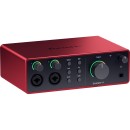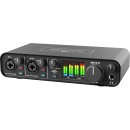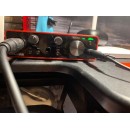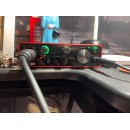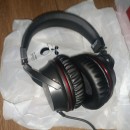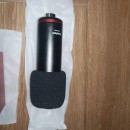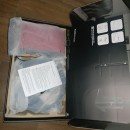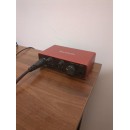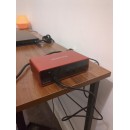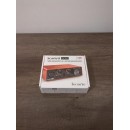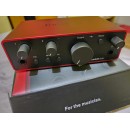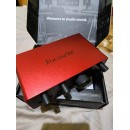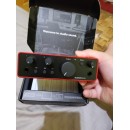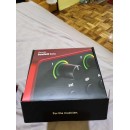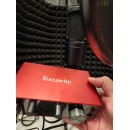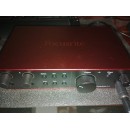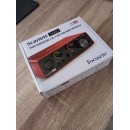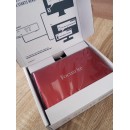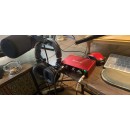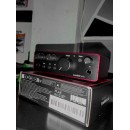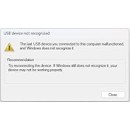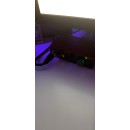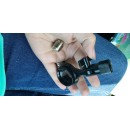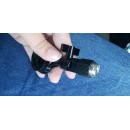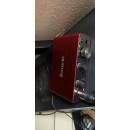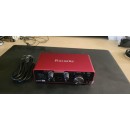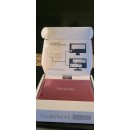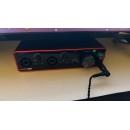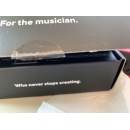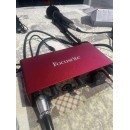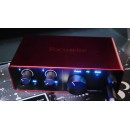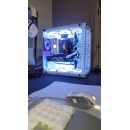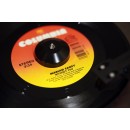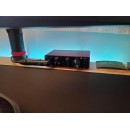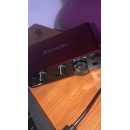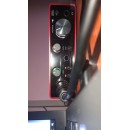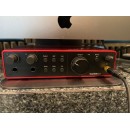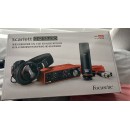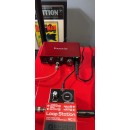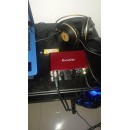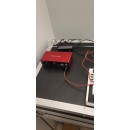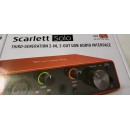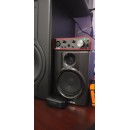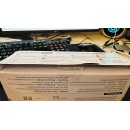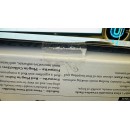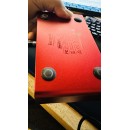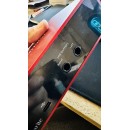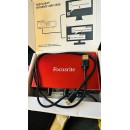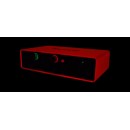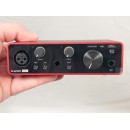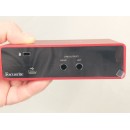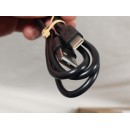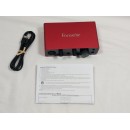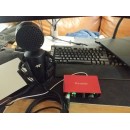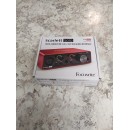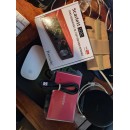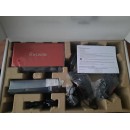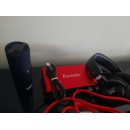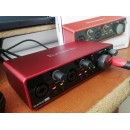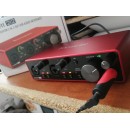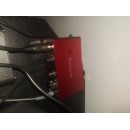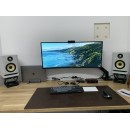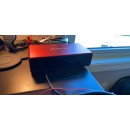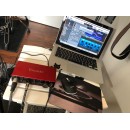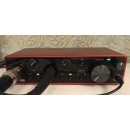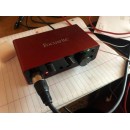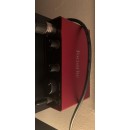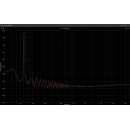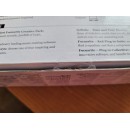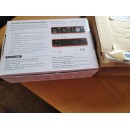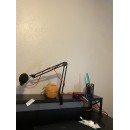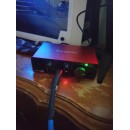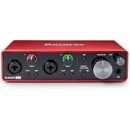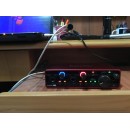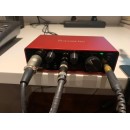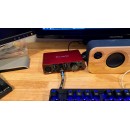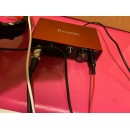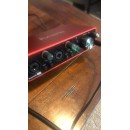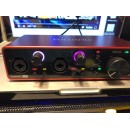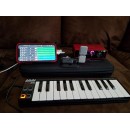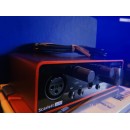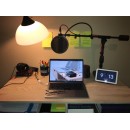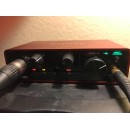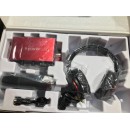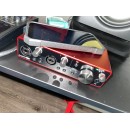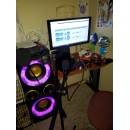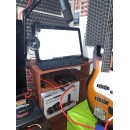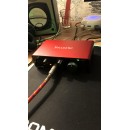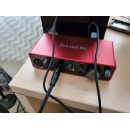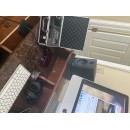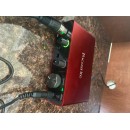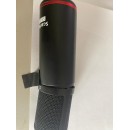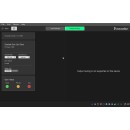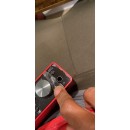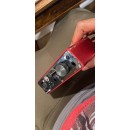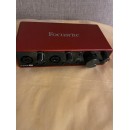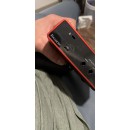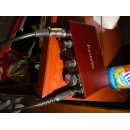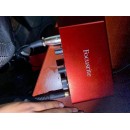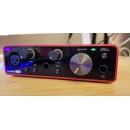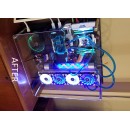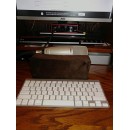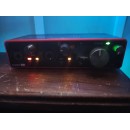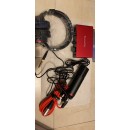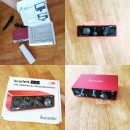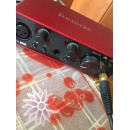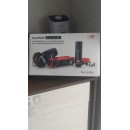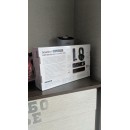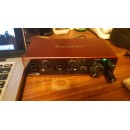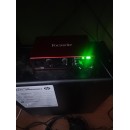MOTU M4 vs Focusrite Scarlett 4i4 (4th Gen): A Comprehensive Comparison
The Focusrite Scarlett 4i4 (4th Gen) continues the brand’s legacy of providing excellent sound quality and robust build. The 4i4 features four balanced line inputs, two Scarlett microphone preamps with high headroom and low distortion, and two high-impedance instrument inputs. This model includes upgraded A-D and D-A converters, delivering 120dB dynamic range for superior sound clarity. The interface supports sample rates up to 192kHz, ensuring high-resolution recordings. With its USB-C connectivity, the Scarlett 4i4 offers low latency and compatibility with both Mac and PC systems. Additionally, it comes with a comprehensive software bundle, including Ableton Live Lite and Pro Tools First, making it an attractive choice for both beginners and seasoned professionals.
On the other hand, the MOTU M4 is known for its ultra-low latency performance and exceptional audio quality. It features four inputs and four outputs, including two mic/line/instrument inputs with preamps that deliver pristine audio. The M4 boasts ESS Sabre32 Ultra™ DAC technology, which provides a 120dB dynamic range and ensures high-fidelity playback. The interface also supports 192kHz sample rates, making it suitable for professional-grade recordings. One standout feature of the MOTU M4 is its full-color LCD screen that provides detailed metering for all inputs and outputs, offering real-time visual feedback that simplifies the recording process. Like the Scarlett 4i4, the MOTU M4 uses USB-C for connectivity, ensuring fast data transfer and compatibility with modern devices.
Both interfaces have MIDI I/O, making them suitable for integrating external MIDI gear. While the Scarlett 4i4 emphasizes ease of use and a robust software package, the MOTU M4 shines with its superior DAC technology and real-time metering. Ultimately, the choice between the two will depend on specific needs, such as the type of projects being worked on and personal preference for interface features.
Specifications, Advantages & Disadvantages
| User Rating Based on Analysis of Reviews | |
|---|---|
|
Show More |
| Pros: | |
|---|---|
|
|
| Cons: | |
|---|---|
|
|
| Key Specs | |
|---|---|
| Channels of I/O | |
| Analog: 4 Inputs / 4 Outputs at 192 kHz |
Analog: 4 Inputs / 4 Outputs |
| Maximum Sampling Rate | |
| 192 kHz / 24-Bit | 192 kHz / 24-Bit |
| Number of Microphone Inputs | |
| 2 | 2 Preamps |
| Analog Audio I/O | |
| 2x Combo XLR-1/4" 3-Pin Balanced/Unbalanced Mic/Line/Hi-Z Input (Front Panel) 2x 1/4" TRS Balanced/Unbalanced Line Input 4x 1/4" TRS Balanced/Unbalanced Line/Monitor Output 1x 1/4" TRS Headphone Output (Front Panel) |
2x Combo XLR-1/4" TRS Balanced/Unbalanced Mic/Line/Hi-Z Input 2x 1/4" TRS Balanced Line Input 1x 1/4" TRS Unbalanced Headphone Output 4x 1/4" TRS Balanced Line Output (DC-Coupled) 4x RCA TS Unbalanced Line Output |
| Host Connection | |
| 1x USB-C | 1x USB-C |
| OS Compatibility | |
| macOS Windows |
macOS 10.11 or Later Windows 7 or Later 9 or Later |
| Power Requirements | |
| USB Bus Power, USB Power Adapter (Not Included) | USB Bus Power |
Both interfaces support a maximum sampling rate of 192 kHz at 24-bit, ensuring high-resolution audio recording and playback. They each provide 4 analog inputs and 4 analog outputs, suitable for a variety of recording and monitoring setups.
The Focusrite Scarlett 4i4 offers 2 combo XLR-1/4" inputs that can handle mic, line, and Hi-Z signals, located on the front panel. Additionally, it provides 2 more 1/4" TRS inputs for line-level signals. For outputs, it includes 4x 1/4" TRS balanced/unbalanced line/monitor outputs and a single 1/4" TRS headphone output on the front panel. The Scarlett 4i4 does not feature any digital audio I/O and is compatible with both macOS and Windows operating systems. It can be powered via USB bus power or an optional USB power adapter, though the adapter is not included.
In comparison, the MOTU M4 also comes equipped with 2 combo XLR-1/4" TRS inputs on the front panel, similarly accommodating mic, line, and Hi-Z signals. It includes 2 additional 1/4" TRS balanced line inputs. The MOTU M4 expands its output options with 4x 1/4" TRS balanced line outputs that are DC-coupled and 4x RCA TS unbalanced line outputs. It also has a 1/4" TRS unbalanced headphone output. The MOTU M4 is compatible with macOS 10.11 or later, Windows 7 or later, and iOS 9 or later, offering broader OS compatibility. It is powered solely via USB bus power.
In summary, while both interfaces provide high-quality audio performance and similar I/O configurations, the MOTU M4 stands out with its additional RCA outputs and broader OS compatibility, whereas the Focusrite Scarlett 4i4 offers a streamlined setup with flexible power options.
| General | |
|---|---|
| Channels of I/O | |
| Analog: 4 Inputs / 4 Outputs at 192 kHz |
Analog: 4 Inputs / 4 Outputs |
| Maximum Sampling Rate | |
| 192 kHz / 24-Bit | 192 kHz / 24-Bit |
| Number of Microphone Inputs | |
| 2 | 2 Preamps |
| Input Level Adjustment | |
| 2x Knob | 2x Knob |
| Expansion Slots | |
The Scarlett 4i4 features two microphone inputs, each with its own knob for input level adjustment, but does not have built-in DSP or built-in microphones. This model also lacks expansion slots, making it a straightforward solution without additional onboard processing capabilities.
Similarly, the MOTU M4 also includes two microphone preamps with individual input level adjustment knobs. Like the Scarlett 4i4, the MOTU M4 does not have built-in DSP or expansion slots, focusing instead on delivering high-quality audio without additional onboard processing.
In summary, both interfaces offer identical channel I/O configurations and maximum sampling rates. They both provide two microphone inputs with individual level adjustments via knobs and do not include built-in DSP, built-in microphones, or expansion slots, making them comparable in terms of core specifications and features.
| Signal Processing | |
|---|---|
| Gain/Trim Range | |
| Mic/Line Inputs: Up to +69 dB Hi-Z Inputs: 62 dB |
Mic Inputs: 0 dB to +60 dB Line/Hi-Z Inputs: 0 dB to +57 dB |
In terms of gain/trim range, the Focusrite Scarlett 4i4 offers a more extensive range. For mic/line inputs, it provides up to +69 dB, and for Hi-Z inputs, it offers up to 62 dB. On the other hand, the MOTU M4 provides a gain range of 0 dB to +60 dB for mic inputs and 0 dB to +57 dB for line/Hi-Z inputs. This indicates that the Scarlett 4i4 may offer more headroom and flexibility for input levels, especially for high-gain applications.
The MOTU M4 lacks several features that are either present or implied in other interfaces. Notably, it does not include a pad, high-pass filter, or solo/mute options. This simplicity might be suitable for users who prefer a straightforward interface without extra features, but it might be a limitation for those who need more advanced input management and signal processing options.
Overall, the Focusrite Scarlett 4i4 appears to offer more versatile input options with its higher gain/trim range, which could be advantageous for recording a wider variety of sources. The MOTU M4, while potentially simpler to use, might be less appealing for those requiring additional input controls and processing features.
| Connectivity | |
|---|---|
| Analog Audio I/O | |
| 2x Combo XLR-1/4" 3-Pin Balanced/Unbalanced Mic/Line/Hi-Z Input (Front Panel) 2x 1/4" TRS Balanced/Unbalanced Line Input 4x 1/4" TRS Balanced/Unbalanced Line/Monitor Output 1x 1/4" TRS Headphone Output (Front Panel) |
2x Combo XLR-1/4" TRS Balanced/Unbalanced Mic/Line/Hi-Z Input 2x 1/4" TRS Balanced Line Input 1x 1/4" TRS Unbalanced Headphone Output 4x 1/4" TRS Balanced Line Output (DC-Coupled) 4x RCA TS Unbalanced Line Output |
| Phantom Power | |
| 48 V, Selectable On/Off | 48 V, Selectable On/Off (Selectable on Individual Inputs) |
| Digital Audio I/O | |
| Host Connection | |
| 1x USB-C | 1x USB-C |
| Host Connection Protocol | |
| USB 2.0 | USB 2.0 |
| USB (Non-Host) | |
| 1x USB-C (Power Input) | |
| Sync I/O | |
| Network I/O | |
| MIDI I/O | |
| 1x DIN 5-Pin Input 1x DIN 5-Pin Output |
1x DIN 5-Pin Input 1x DIN 5-Pin Output |
The Focusrite Scarlett 4i4 offers 2x combo XLR-1/4" 3-pin balanced/unbalanced mic/line/Hi-Z inputs on the front panel, as well as 2x 1/4" TRS balanced/unbalanced line inputs. It provides 4x 1/4" TRS balanced/unbalanced line/monitor outputs in addition to a 1/4" TRS headphone output, also on the front panel. Phantom power is selectable at 48 V. For MIDI connectivity, it includes 1x DIN 5-pin input and 1x DIN 5-pin output. Notably, the Scarlett 4i4 utilizes a USB-C connection for the host with USB 2.0 protocol and requires a separate USB-C power input.
In contrast, the MOTU M4 features similar analog audio I/O with 2x combo XLR-1/4" TRS balanced/unbalanced mic/line/Hi-Z inputs and 2x 1/4" TRS balanced line inputs. Its outputs differ slightly, with 4x 1/4" TRS balanced line outputs (DC-coupled) and 4x RCA TS unbalanced line outputs, providing more flexibility for different output requirements. The M4 also includes a 1/4" TRS unbalanced headphone output. Phantom power is selectable at 48 V and is individually selectable on each input. Like the Scarlett 4i4, the M4 features 1x DIN 5-pin input and 1x DIN 5-pin output for MIDI connectivity, and it connects to the host via USB-C with USB 2.0 protocol. However, it does not require an additional USB-C power input.
Both interfaces offer similar front panel inputs and MIDI I/O, but the M4 provides additional RCA outputs and selectable phantom power on individual inputs, possibly making it more versatile for certain setups. The Scarlett 4i4, on the other hand, offers a straightforward setup with a dedicated USB-C power input, potentially appealing to users looking for a simpler power solution.
| Performance | |
|---|---|
| Frequency Response | |
| Combo XLR-1/4" Mic Inputs: 20 Hz to 20 kHz ±0.06 dB Combo XLR-1/4" Line Inputs: 20 Hz to 20 kHz ±0.05 dB Combo XLR-1/4" Hi-Z Inputs: 20 Hz to 20 kHz ±0.15 dB 1/4" Line Inputs: 20 Hz to 20 kHz ±0.02 dB |
Mic Inputs: 20 Hz to 20 kHz +0/-0.1 dB Line, Hi-Z Inputs: 20 Hz to 20 kHz ±0.15 dB Line Inputs: 20 Hz to 20 kHz ±0.07 dB Line Outputs: 20 Hz to 20 kHz +0/-0.1 dB |
| Maximum Input Level | |
| Combo XLR-1/4" Mic: 16 dBu Combo XLR-1/4" Line: 22 dBu Combo XLR-1/4" Hi-Z: 12 dBu 1/4" Line: 22 dBu |
Mic Inputs: +10 dBu (Min Gain) Line/Hi-Z Inputs: +16 dBu (Min Gain) Line Inputs: +18 dBu (Min Gain) |
| Maximum Output Level | |
| 1/4" Line: +16 dBu |
Line Outputs: +16 dBu (Balanced) Line Outputs: +9.5 dBu (Unbalanced) Headphone Outputs: +12.5 dBu |
| Impedance | |
| Combo XLR-1/4" Mic Inputs: 3 Kilohms Combo XLR-1/4" Line Inputs: 60 Kilohms Combo XLR-1/4" Hi-Z Inputs: 1 Megohms 1/4" Line Inputs: 60 Kilohms 1/4" Line Outputs: 100 Ohms 1/4" Headphone Outputs: < 11 Ohm |
Mic Inputs: 2.65 Kilohms Line Inputs: 2 Megohms Hi-Z Inputs: 1 Megohm Line Outputs: 100 Ohms |
| Dynamic Range | |
| Combo XLR-1/4" Mic Inputs: 116 dBA Combo XLR-1/4" Line Inputs: 115.5 dBA Combo XLR-1/4" Hi-Z Inputs: 113 dBA 1/4" Line Inputs: 115.5 dBA 1/4" Line Outputs: 120 dB 1/4" Headphone: 112 dB (at 33 Ohms) 115 dB (at 300 Ohms) Digital A/D Converters: 130 dB Digital D/A Converters: 130 dBA |
Mic Inputs: 115 dBA Line/Hi-Z Inputs: 114 dBA Line Inputs: 115 dBA Line/Monitor Outputs: 120 dBA RCA Outputs: 119 dBA Headphone Outputs: 115 dBA |
| THD+N | |
| Combo XLR-1/4" Mic Inputs: -100 dB (at 8 dB Gain) Combo XLR-1/4" Line Inputs: -100 dB (at 8 dB Gain) Combo XLR-1/4" Hi-Z Inputs: -80 dB (at Minimum Gain) 1/4" Line Inputs: -105 dB 1/4" Line Outputs: -112 dB 1/4" Headphone Outputs: -99 dB (at 33 Ohms) -108 dB (at 300 Ohms) Digital A/D Converters: -115 dB Digital D/A Converters: -115 dB |
Mic Inputs: < -97 dB / < 0.0014% Line/Hi-Z Inputs: < -100 dB / < 0.001% Line Inputs: < -106 dB / < 0.0005% Line/Monitor Outputs: < -110 dB / < 0.00032% RCA Outputs: < -105 dB / < 0.00056% Headphone Outputs: < -110 dB / < 0.0003% |
| EIN | |
| Combo XLR-1/4" Mic Inputs: -127 dBu A-Weighted |
Mic Inputs: -129 dB A-Weighted (150-Ohm Source, Max Gain) |
In terms of frequency response, the Focusrite Scarlett 4i4 provides a flat response across various input types, with a range of 20 Hz to 20 kHz and deviations as low as ±0.02 dB for 1/4" line inputs. The MOTU M4 also covers the full 20 Hz to 20 kHz range but with slightly higher deviations, such as ±0.1 dB for mic inputs and ±0.15 dB for line and Hi-Z inputs.
Regarding maximum input levels, the Focusrite Scarlett 4i4 accommodates up to 16 dBu for XLR-1/4" mic inputs, 22 dBu for line inputs, and 12 dBu for Hi-Z inputs. In contrast, the MOTU M4 supports up to +10 dBu for mic inputs, +16 dBu for Hi-Z inputs, and +18 dBu for line inputs, showing a slightly higher maximum input level for line inputs compared to the Scarlett 4i4.
For maximum output levels, both interfaces offer +16 dBu for balanced line outputs. However, the MOTU M4 provides an additional detail with its unbalanced line outputs at +9.5 dBu and headphone outputs at +12.5 dBu, which is higher than the Scarlett 4i4's headphone outputs of 57 mW into 33 Ohms and 27 mW into 300 Ohms.
Impedance values are also crucial for matching sources and loads. The Focusrite Scarlett 4i4 presents an impedance of 3 Kilohms for mic inputs, 60 Kilohms for line inputs, 1 Megohm for Hi-Z inputs, and 100 Ohms for line outputs. The MOTU M4 features lower mic input impedance at 2.65 Kilohms but higher line input impedance at 2 Megohms, while maintaining the same 100 Ohms for line outputs.
Dynamic range is a measure of the interface's ability to handle various signal levels without distortion. The Focusrite Scarlett 4i4 boasts a high dynamic range, with 116 dBA for mic inputs, 115.5 dBA for line inputs, and 120 dB for line outputs. The MOTU M4 closely matches this performance with a dynamic range of 115 dBA for mic inputs and 120 dBA for line/monitor outputs, indicating similar capabilities in handling dynamic audio signals.
When comparing THD+N, the Focusrite Scarlett 4i4 has very low distortion levels, with -100 dB for mic and line inputs and -112 dB for line outputs. The MOTU M4 performs similarly, with mic inputs at < -97 dB and line inputs at < -106 dB. Both interfaces thus ensure minimal distortion, providing clean and accurate audio reproduction.
Lastly, the Equivalent Input Noise (EIN) for mic inputs is an important factor for capturing quiet sources without added noise. The Focusrite Scarlett 4i4 has an EIN of -127 dBu A-weighted, whereas the MOTU M4 slightly outperforms it with an EIN of -129 dB A-weighted, indicating a marginally lower noise floor.
In summary, both the Focusrite Scarlett 4i4 and the MOTU M4 offer robust features suitable for various recording applications. The Scarlett 4i4 excels in input level handling and impedance matching, while the MOTU M4 offers slightly better maximum input levels, dynamic range for line outputs, and lower EIN for mic inputs. Each interface provides excellent performance, but the choice between them may come down to specific needs regarding input handling, output power, and noise performance.
| Digital Audio | |
|---|---|
| Sample Rates | |
| 44.1 / 48 / 88.2 / 96 / 176.4 / 192 kHz | Up to 192 kHz |
| Bit Depths | |
| 24-Bit | 24-Bit |
| Sync Sources | |
| Internal | Internal |
The Focusrite Scarlett 4i4 supports a range of sample rates including 44.1, 48, 88.2, 96, 176.4, and 192 kHz, allowing for versatile recording options. It operates at a bit depth of 24-bit, ensuring high-resolution audio capture. The sync source for the Scarlett 4i4 is internal, maintaining a simplified setup for users who do not need external synchronization.
On the other hand, the MOTU M4 also supports sample rates up to 192 kHz, providing equally high-quality recording capabilities. It too operates at a bit depth of 24-bit. One significant feature of the MOTU M4 is its zero-latency direct monitoring, providing real-time tracking without delay, which is particularly beneficial during live recording sessions. The latency is specified at 2.5 ms at 96 kHz, although this can vary depending on the buffer size and specific hardware configurations. Similar to the Scarlett 4i4, the MOTU M4 uses an internal sync source.
In summary, both interfaces offer robust audio recording capabilities with sample rates up to 192 kHz and 24-bit depth. The Focusrite Scarlett 4i4 provides a straightforward internal sync source and a variety of sample rates, making it a versatile choice for various recording scenarios. The MOTU M4 stands out with its zero-latency direct monitoring feature, which is ideal for users who prioritize real-time performance. Both interfaces are excellent choices, but the MOTU M4 may have a slight edge for those who need immediate audio feedback during recording.
| Audio Storage & Playback |
|---|
| Compatibility | |
|---|---|
| OS Compatibility | |
| macOS Windows |
macOS 10.11 or Later Windows 7 or Later 9 or Later |
When it comes to OS compatibility, the Focusrite Scarlett 4i4 supports both macOS and Windows, with additional compatibility for iPadOS via a mobile app. This makes it a versatile option for users who may want to use it with multiple devices, including iPads for mobile recording setups.
In contrast, the MOTU M4 also supports both macOS (10.11 or later) and Windows (7 or later), but it does not mention specific compatibility with mobile operating systems like iPadOS. This may limit its usage in more portable or iOS-centered recording environments.
Focusing on processor requirements, the MOTU M4 specifies that it requires a 1 GHz Intel processor for both Mac and PC users. Additionally, it recommends having at least 2 GB of RAM, with 4 GB being preferable. It also explicitly states the need for an available USB 2.0 port and an internet connection for software or driver downloads, ensuring users are aware of these prerequisites for optimal performance. The inclusion of the necessary USB cable is a thoughtful touch, ensuring that users have everything they need to get started right out of the box.
The Focusrite Scarlett 4i4 does not provide specific details regarding processor requirements, RAM, or the need for an internet connection for driver downloads in its basic specifications. This lack of detailed hardware requirements might suggest a broader compatibility with different system configurations but could also leave users guessing about the minimum system requirements needed for optimal performance.
In summary, both interfaces offer robust OS compatibility with macOS and Windows, but the Focusrite Scarlett 4i4 extends its versatility with iPadOS support. On the other hand, the MOTU M4 provides detailed hardware requirements, ensuring users are well-informed about the necessary system specifications for smooth operation. Each interface brings its strengths to the table, catering to different user needs and preferences in the audio recording landscape.
| Power | |
|---|---|
| Power Requirements | |
| USB Bus Power, USB Power Adapter (Not Included) | USB Bus Power |
The Focusrite Scarlett 4i4 (4th Generation) can be powered via USB bus power or an optional USB power adapter, providing flexibility depending on the user's setup. Additionally, it includes a 5 VDC at 3 A AC/DC power adapter. The unit consumes 7.5 W of power, which indicates a need for a relatively moderate power draw compared to some other audio interfaces.
On the other hand, the MOTU M4 USB-C Audio-MIDI Interface is strictly powered via USB bus power, simplifying the power requirements but also potentially limiting its use to scenarios where sufficient USB power is available. This could be advantageous for users who prefer a more straightforward setup without the need for additional power adapters.
In summary, the Focusrite Scarlett 4i4 offers more versatility with multiple power options and comes with an AC/DC adapter, while the MOTU M4 focuses on simplicity by relying solely on USB bus power. The higher power consumption of the Scarlett 4i4 may reflect its broader feature set or more complex internals, whereas the MOTU M4’s USB-only power requirement might make it more convenient for certain users but with potential limitations in power availability.
| Physical | |
|---|---|
| Dimensions | |
| 7.09 x 5.08 x 2.32" / 18.01 x 12.9 x 5.89 cm | 8.25 x 4.25 x 1.75" / 20.96 x 10.79 x 4.45 cm (Chassis Only) |
| Weight | |
| 1.8 lb / 816.0 g | 1.6 lb / 0.7 kg |
In terms of dimensions, the Focusrite Scarlett 4i4 measures 7.09 x 5.08 x 2.32 inches (18.01 x 12.9 x 5.89 cm), making it a relatively compact and portable option. On the other hand, the MOTU M4 is slightly larger with dimensions of 8.25 x 4.25 x 1.75 inches (20.96 x 10.79 x 4.45 cm), giving it a slightly different form factor that may appeal to users with specific space requirements.
Regarding weight, the Focusrite Scarlett 4i4 weighs in at 1.8 lb (816.0 g), which is slightly heavier compared to the MOTU M4, which weighs 1.6 lb (0.7 kg). The difference in weight might be a minor consideration for users who prioritize portability.
The MOTU M4 includes an anti-theft feature with a Kensington Security Slot, offering additional security for users who need to protect their device in various environments. The Focusrite Scarlett 4i4 does not list any specific anti-theft features, which might be a consideration for users in settings where security is a concern.
Overall, both interfaces provide robust features suitable for different studio and recording needs, with the Focusrite Scarlett 4i4 being slightly more compact and the MOTU M4 offering additional security features.
| Packaging Info | |
|---|---|
| Package Weight | |
| 3.185 lb | 2.15 lb |
| Box Dimensions (LxWxH) | |
| 11.2 x 8 x 3.6" | 10.6 x 7.3 x 2.8" |
The Focusrite Scarlett 4i4 (4th Generation) comes with a package weight of 3.185 lb and box dimensions measuring 11.2 x 8 x 3.6 inches. This indicates a robust packaging strategy that likely ensures the device's safety during transport, with a slightly larger footprint that could accommodate additional accessories or more substantial padding.
On the other hand, the MOTU M4 USB-C Audio-MIDI Interface is packaged with a weight of 2.15 lb, making it noticeably lighter than the Scarlett 4i4. Its box dimensions are 10.6 x 7.3 x 2.8 inches, which suggests a more compact and potentially more portable solution. The smaller size could be advantageous for users with limited desk space or those who prioritize ease of transportation.
In conclusion, the Focusrite Scarlett 4i4's heavier weight and larger dimensions may appeal to users looking for a more substantial feel and possibly more comprehensive accessory inclusion. Meanwhile, the MOTU M4's lighter and more compact packaging might be preferable for users seeking portability and space efficiency.
| Customer Images | |
|---|---|
| Videos | |
|---|---|
|
|
|
